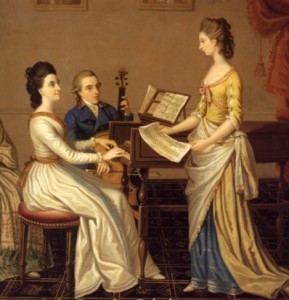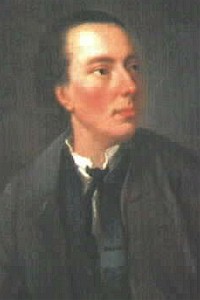1709-1770
Early Years
Charles Avison was born in Newcastle upon Tyne in 1709 being baptised at St. John’s Church on 16th February. He was the fifth of nine children of Richard and Anne Avison who lived in the house beside St. Bartholomew’s Nunnery in Nolt Market, Newcastle. They were both were musicians and were presumably Avison’s first music teachers. Richard was a member of the ancient Incorporated Company of Town Waits i.e. a member of the official town band, who was licensed to teach music in his spare time. He was paid the very small salary of £4 per annum (plus a uniform – valued at £5 when a cash substitute was offered) which he presumably supplemented with teaching. His wife Ann was a church organist.
As Avison’s first published composition (Six Sonatas for Two Violins and Continuo) was dedicated to Ralph Jenison (1696-1758) it is presumed that Jenison had some early connections with the composer. Jenison, a patron of the arts, was from an old Newcastle family and was elected Member of Parliament for Northumberland from 1734 to 1741. Jenison’s association with music is evidenced by the fact that Johann Pepusch (1667-1752) dedicated his edition of Corelli’s concertos to him. Avison was later assisted in his studies by Colonel John Blaithwaite who was a retired director of the Royal Academy of Music. During the period with Jenison, Avison must have moved to London, as according to the music historian Charles Burney, he studied music there with the Italian composer Francesco Geminiani (1687-1762).
1734
The first recorded mention of Avison’s musical life was reference to a concert for his benefit at Hickford’s Room, London on 20th March 1734.
1735/6
On 13th October 1735 he was appointed organist of St, John’s Church, Newcastle and was then offered a similar position in October 1736 at St. Nicholas’s, now the Cathedral, at a salary of £20 per annum. In the same month Avison conducted a series of subscription concerts in Newcastle – similar to those running in London – in the name of the Newcastle Musical Society. They took the format of a series of 14 concerts – held fortnightly – each winter. In July 1738 he was formally appointed musical director.
We have knowledge of his teaching practice through the following announcement:
“Mr. Avison begs to acquaint his friends that Mondays and Fridays are set apart for his teaching in Newcastle He proposes to attend young ladies on the harpsichord between the hours of 9 and 1 in the forenoon; and from 2 to 6 in the evening he will teach the violin and German flute. The terms are half-a-guinea per month (or eight lessons) and one guinea Entrance.”
On Tuesdays he travelled the 20 miles to Durham to participate in the subscription concerts given by John Garth (Avison and Garth also collaborated to form a Marcello society in Newcastle devoted to performing the choral music of Benedetto Marcello). On Wednesdays he was involved in local theatre activities – probably supplying music for the play intervals – as was customary at that time. He retained this position as well as that of Cathedral organist until his death. He also organised benefit concerts and musical events at the Newcastle Pleasure Gardens.
He was obviously much attached to his home town of Newcastle, refusing many prestigious positions offered to him in other parts of the country, i.e. organist at York Minster in 1734 (accepted by James Nares), recommendations from Geminiani of two organist posts in Dublin between 1733 and 1740, a teaching position in Edinburgh and as successor to Pepusch as organist at the Charterhouse in London.
1737
On 15th January 1737 Avison married Catherine Reynolds. They had nine children but only three reached adulthood: Jane (1744-1773), Edward (1747-1776) who, following in his father’s footsteps became organist of the church of St. Nicholas and also director of the Newcastle Music Society and Charles (1751-1795) who also became organist at St. Nicholas and a composer of several works including a hymn collection.
1752
In 1752 Avison’s fame spread nation-wide with the publication of his celebrated Essay of Musical Expression – the first English work on musical criticism.
In it Avison discusses the contrast between sublime music and beautiful music, between the great, the elevating and the inspiring in contrast to the graceful, the elegant and the gentle and as to what is merely pleasing. In giving musical examples he went against the general view of Handel’s genius and accordingly upset many Handelians. One of these, William Hayes, wrote a pamphlet (published in 1753) called ‘Remarks on Mr. Avison’s Essay on Musical Expression’ .
Soon afterwards a second edition of Avison’s Essay was published containing a ‘reply’ to Hayes’s ‘Remarks’. Later, a third part was published entitled ‘On Musical Expression as it relates to the performer’. In this he discusses the actual practice of music in his lifetime – it has been described as a miniature treatise on orchestration.
In it he advises the composer to:
“minutely observe the different qualities of the instruments themselves. For, as vocal music requires one kind of expression, and instrumental another, so different instruments have also a different expression peculiar to them. Thus, the hautboy will best express the cantabile, or singing style, and may be used in all movements whatever under this denomination; especially those movements which tend to the gay and cheerful.”
“The flute”, he said, “will best express the languishing or melancholy style”.
He recommends the bassoon as a continuo instrument, “if performed by an expert hand, in a soft and ready tone, and only in passages that are natural to it, [the bassoon] may then be of singular use, and add fullness to the harmony”.
1760
Geminiani visited Avison in his home town during 1760 breaking a journey between Edinburgh and London.
1770
Avison died on 10th May 1770 and was buried in the churchyard of St. Andrew’s, Newgate Street, Newcastle.
Charles Burney described Avison was “an ingenious and polished man, esteemed and respected by all that knew him; and an elegant writer upon his art”.
Discography
Hyperion CDA66891/2
12 Concerti Grossi after Scarlatti (arrangements by Avison of sonatas by Scarlatti)
Divine Art 24108
Avison: The Six Concerti from Opus 9
(The Georgian Concert)



Pingback: Baroque 4×4 Festival at St. Peter’s Lutheran Church | I Confessor
Pingback: Music Review: Baroque 4×4 Festival at St. Peter’s Lutheran Church | Enchanted Tickets Service
I recently heard Avison’s Concerto No. 5 on the Williamsburg, VA classical radio station. It was so captivating. I found an excellent performance of it on Youtube. I also love the music of Vivaldi, J.S. Bach, Handel, Telemann, Corelli, Rameau, Geminiani, Tartini, Samartini, Albinoni, Pachelbel, and Dominico and Alasandro Scarlotti. They all wrote with such creativity and excellence. It’s evident they were very self-disciplined. Their music is such a reflection of what the Scripture says, that man was made in the image and likeness of God.
Just heard one of his concertos on BBC Radio 3 – they’re running a series about him this week. It’s highly informative and full of some wonderful music. You should be able to pick it up online at BBC website.
We clearly have similar tastes. Have you come across Antonio Teixeira’s magnificent Te Deum? There’s a recording by The 16 – it might blow your socks off!
Roger this is a most interesting article. I am conducting a concert on November 2nd next at the Literary and Philosophical Society in Newcastle upon Tyne. The programme is “bookended” by two of Avison’s op 9 – the E minor and the G major.
Not that it matters, but the Lit and Phil is located about 150 yards west of Newcastle Cathedral of St Nicholas, about 50 yards south of St John’s, and about 200 yards south of St Andrews. I would very much like to incorporate some of the material in your note above in my programme notes – should you give permission I would be happy to acknowledge you as the source.
See what you think.
John Pearce
The Baroque period of music is my favourite listening schedule. Thank you for your invaluable information on Charles Avison and John Garth.
We hear a lot of music of Handel and Purcell but little else of British composers of this period.
Pingback: Bygone concert venues 6.1: Black Bear Inn. Mr. Incledon comes to Cambridge | MusiCB3 Blog
Hi – thanks for your very informative site on C18th music, and all the knowledge which you have generously shared. I am preparing a workshop for the Beverley Early Music Festival on the 26th May, and I’m researching some hymns I have found with Yorkshire place tune-names (Helmsley, Leeds etc) in a Hymn Book from St Mary’s Church Hull 1787 containing only words. I’ve tracked the tunes down to Martin Madan’s ‘Lock Hospital Hymn Book’. I’ve noticed that the publication of this hymn book, the aim of which was to re-vitalise congregational singing at the church, coincides with the accession of a new organist at the church in that year, Thomas Hawdon. There’s lots of useful information on your site about the links between him, his father, also an organist, and his teacher Avison. I imagine that the publication of the hymn book, and the new organist in the same year is possibly connected. Anyway – thanks again for making your work so accessible. best wishes, Vivien